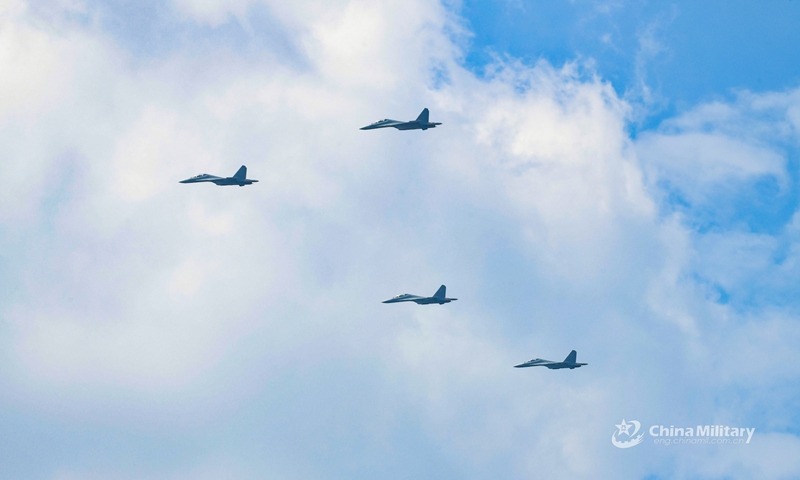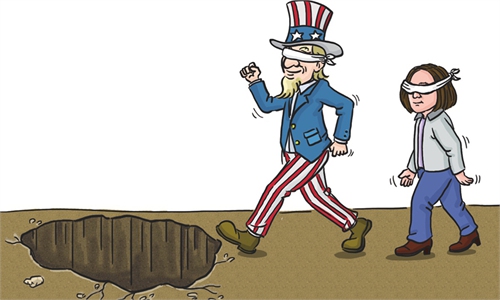PLA sends 29 warplanes around Taiwan, ‘practices new tactics to counter US aircraft carrier intervention’

Four fighter jets attached to an aviation brigade of the air force under the PLA Eastern Theater Command soar in the sky in V-formation during a flight training exercise on May 14, 2022.Photo:Xinhua
Twenty-nine Chinese People's Liberation Army (PLA) warplanes entered the island of Taiwan's self-proclaimed air defense identification zone on Tuesday, marking the third largest PLA aerial drill around Taiwan this year, which according to Chinese military observers indicated that the PLA could be practicing new tactics to counter possible US aircraft carrier intervention.
The 29 warplanes, namely a Y-9 electronic warfare aircraft, a Y-8 electronic intelligence aircraft, six H-6 bombers, a Y-20 aerial refueling aircraft, two KJ-500 early warning aircraft, eight J-16 fighter jets, four Su-30 fighter jets, five J-11 fighter jets and a Y-8 anti-submarine warfare aircraft, entered Taiwan's self-proclaimed southwest air defense identification zone on Tuesday, the defense authority on the island said in a press release on the day.
This marks the third largest PLA aerial drill around Taiwan in 2022. The largest drill featured 38 warplanes on January 23, and second largest featured 30 warplanes on May 30, media on the island reported. The all-time record is 56, which took place on October 4, 2021.
The PLA's drill came amid the US' increasingly radical and dangerous moves over the Taiwan question, including challenging the one-China policy and hyping the legal status of the Taiwan Straits, with experts believing the US is moving away from its decades of strategic ambiguity over Taiwan to cater to its China policy featuring competition and confrontation. The moves came ahead of the G7 Summit and NATO Summit, and analysts said the US plans to incite his allies, especially those in Europe, to jointly create turmoil in the Asia-Pacific region for its strategic goal of containing China.
They warned that the US' dangerous moves will only increase the risk of clashes between China and the US, and being a pawn in the US' hardline strategy toward China could lead the island to a catastrophic consequence it cannot afford as the Chinese mainland has a lot of cards, including military cards.
Analysts said that the PLA has made patrols and exercises around the island of Taiwan routine, and with every drill the PLA has enhanced its combat preparedness. The 29 warplanes on Tuesday indicated that the PLA could be practicing some of its new tactics to counter possible US aircraft carrier intervention and boost the loitering time of the PLA aircraft with aerial refueling.
According to the flight paths provided by the Taiwan defense authority, the PLA aircraft likely operated in three groups, a Chinese mainland military expert told the Global Times on Wednesday, requesting anonymity.
The first group consisted of a Y-9 electronic warfare aircraft, a Y-8 electronic intelligence aircraft and six H-6 bombers, as they flew from the Chinese mainland to the southwest of Taiwan, crossed the Bashi Channel south of it, reached the southeast side of the island, and then returned from the same course after going deep in the Philippine Sea. This group likely carried out an anti-access/area denial exercise against possible intervention by US aircraft carriers, as a large fleet of H-6 bombers could launch saturation attacks with anti-ship missiles under the cover and support of electronic warfare and intelligence aircraft.
A US aircraft carrier, the USS Abraham Lincoln, has been operating in the Philippine Sea recently, according to the US 7th Fleet on Wednesday. When US aircraft carriers previously approached Taiwan island and the South China Sea, the PLA also dispatched bombers, apparently to "greet" them, observers said.
The second group consisted of a Y-20 aerial refueling aircraft, two KJ-500 early warning aircraft and 17 fighter jets, as they operated relatively away from the island of Taiwan and closer to the Taiwan-administered Dongsha Islands in the South China Sea. The fighter jets likely served the purpose of seizing air superiority and escorting the Y-20 aerial refueling aircraft and KJ-500 early warning aircraft in a safe zone, as the latter are vulnerable to attacks on their own but can provide key battlefield advantages.
With the Y-20 aerial refueling aircraft, other warplanes can have longer loitering time and remain in operation for longer durations without having to return to base. With the KJ-500 early warning aircraft, the PLA can enjoy superior battlefield awareness, and fighter jets can launch attacks without using their own radars thanks to guidance data from the KJ-500s, analysts said.
The third group, consisting of only a Y-8 anti-submarine warfare aircraft, patrolled the waters southwest of the Taiwan Straits. It could be on a lookout for both hostile underwater and surface activities, and share the intelligence with other maritime and aerial units.
This seems to be the first time the PLA has practiced this combination of tactics in the routine drills around the island of Taiwan, and it is very combat-oriented, showing that the PLA's combat preparedness is being enhanced every day, experts said.
"Taiwan independence" secessionists and foreign interference forces must understand the PLA's determination, confidence and capability in resolving the Taiwan question by force if it comes to that, and they must stop all provocations or suffer the consequences, they said.
More radical moves
Former US defense secretary Mark Esper said on Tuesday that the one-China policy has outlived its usefulness, saying people in the island identify them as "Taiwanese" and Taiwan has a robust democracy and economy, according to the McCain Institute.
A Shanghai-based scholar in American studies who requested anonymity called Esper's remarks "nonsense and irresponsible" which he made in order to make profit.
How people in Taiwan identify themselves and where its politics goes cannot change the fact that Taiwan is part of China, the scholar told the Global Times.
Esper was clarifying the connotation of the one-China policy, which has been repeatedly emphasized in the US' China policy and has been hollowed out by the US, and his message was that Taiwan island is not part of China, a Beijing-based professor from China Foreign Affairs University who requested anonymity told the Global Times, calling it a very dangerous move of the US' Taiwan policy.
China has repeatedly said the Taiwan question is the most important and sensitive issue in China-US relations and the core of the Taiwan question is "one China."
If the US government changed it, it would completely wreck China-US relations, the scholar warned.
The US has also claimed several times that the Taiwan Straits is an international waterway, when there is no such thing as "international waters" in the United Nations Convention on the Law of the Sea.
Analysts said the US' radical moves on the Taiwan question recently showed its strategic purpose of trying to create turmoil and crisis in the Asia-Pacific region to contain China, as Taiwan is seen by the US as its most effective card.
The US increasingly views the Asia-Pacific region as the core of its global strategy, and Taiwan is an important part of it, the scholar said.
For its allies, US' approaches to Taiwan also served as a litmus test for the credibility of US commitments to allies, he said.
And the US has repeatedly hyped that China is going to resolve the Taiwan question by force to influence the G7 Summit this week and NATO Summit next week, so that the US' European allies could be lured to work with the US for its strategic competition and confrontation with China, the anonymous expert said.
A series of recent provocative moves to hollow out the one-China principle including announcing new arms sales to Taiwan and sending officials to the island showed the US is reneging on its own commitments to China as it continued going down its wrong path of viewing China as its rivalry, which does little to soothe the already complicated and intense bilateral relations but adding more stumbling blocks, analysts said.
US President Joe Biden has told Chinese President Xi Jinping in their phone call that the US does not seek a new Cold War with China; does not aim to change China's system; the revitalization of its alliances is not targeted at China; the US does not support "Taiwan independence"; and it has no intention to seek a conflict with China.
According to US media reports, Biden said Saturday that he plans to talk to Xi again soon, and Chinese Foreign Ministry spokesperson Wang Wenbin said at Wednesday's media briefing that it's very important for leaders of China and the US to maintain exchanges, but the two sides should reach consensus through diplomatic channels and create favorable conditions and atmosphere for such exchanges.



